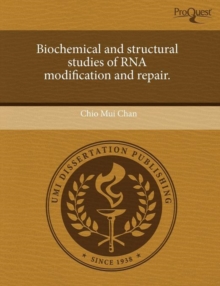RNA modification, RNA interference, and RNA repair are important events in the cell.
This thesis presents three projects related to these three fields.
By using both biochemical and structural methods, we characterized enzymatic activities of pseudouridine synthase TruD, solved the structure of A. aeolicus GidA, and reconstituted a novel bacterial RNA repair system against ribotoxins in vitro.
Pseudouridinc synthases (PsiS) catalyze the isomerization of uridine to pseudouridine (Psi).
To date, there are total of five families of PsiS: TruA, TruB, RsuA, RluA, and TruD.
TruD is the fifth family discovered which modifies tRNAGlu U13 to Psi13.
In this study, I measured the enzymatic parameters for TruD in E.coli and carried out enzymatic assays for a series of single, double, and triple TruD mutants.
All of the double and triple mutations abolished the TruD enzymatic activity.
Based on our mutational results, we proposed that a Glu in the active site may function as the general base in TruD, resulting in a mechanism catalyzed by TruD which is distinct from the first four families.
To further understand on GidA and tRNA interactions, I purified GidA alone and GidA-tRNAGlu as a stable complex by size exclusion chromatography and carried out its crystallization screening.
Although no complex crystal is observed yet, we obtained crystals from Se-GidA protein alone and solved a crystal structure of A. aeolicus GidA at 3.2 A resolution. Based on structure analysis, we proposed a docking model to show the complex interactions between GidA and tRNA.
In RNA inference, Hen1 methylates 3' terminus of small RNA (∼20--30 nt) through 2'-O-methylation.
After being generated by Dicer or Piwi proteins, all small RNAs in plants and a subset of small RNAs in animals are further methylated by Hen1, which may enhance the function or prevent degradation of the RNAs.
Hen1 homologs are also found in a subset of bacteria species, but their biological function is not known.
I carried out methylation assays to show that full length and methyltransferase domain of bacterial Hen1 from C. thermocellum and A. variabilis (CtHen1 and AvHen1 for full length; CtHen1- C and AvHen1-C for methyltransferase domain) were able to methylate small RNAs from 21 nt to 30 nt.
We determined the crystal structures of the CtHen1-C alone and AvHen1-C with AdoHcy bound.
After analyzing Hen1 structures, we built a docking model to show interaction between RNA substrate and the methyltransferase domain of bacteria Hen1, which was supported by site-directed mutagenesis.
RNA Repair is a mechanism that rectifies purposeful breaks in tRNAs and mRNAs occurred during RNA processing and under cellular stress.
To date, only two repair-like and repair pathways have been identified: yeast-type and phage-type, respectively.
In our studies, we identified a bacterial RNA repair system composed of bacterial Pnkp and Hen1.
Hen1 and Pnkp appeared pair-wise in the same operon in 39 of 934 bacterial species.
Pnkp has been shown to have kinase, phosphatase, and adenylyltransferase activities, which are hallmarks of RNA repair.
However, Pnkp alone is not sufficient for ligation. Pnkp/Hen1 was shown to form a tetramer during purification in size exclusion gel filtration.
I carried out biochemical assays to show that AvPnkp/ AvHen1 (from A.variabilis) heterotetramer possessed ligation activity.
We concluded that AvPnkp/AvHen1 belonged to a novel RNA repair and modification system.
AvPnkp/ AvHen1 not only repairs tRNAAsp and tRNAArg cleaved by ribotoxins colicin E5 and colicin D, respectively, but also adds a methyl group to the same 2'OH group, which acts as a nucleophile during RNA cleavage by the...

